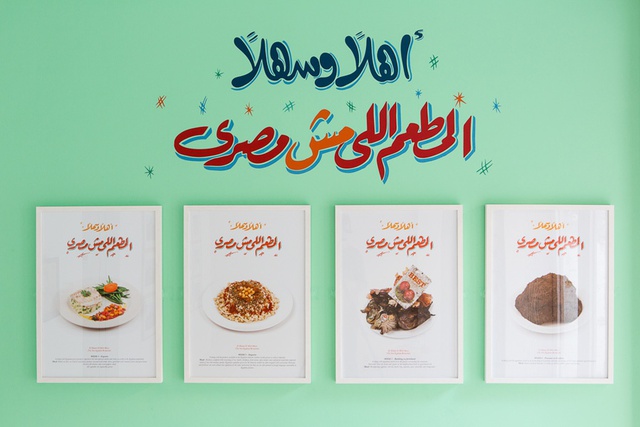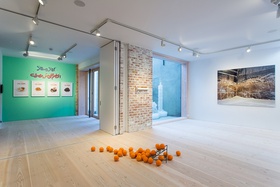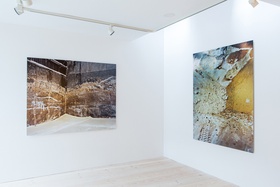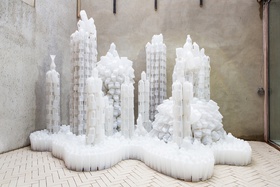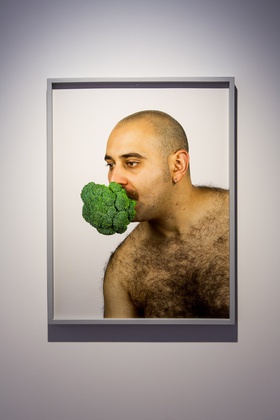Reviews
We Are What We Eat
The Politics of Food at Delfina Foundation
With the unveiling of its refurbished and expanded space in January 2014, Delfina Foundation launched The Politics of Food, a four-year programme of artistic research and production that invites artists, curators and critics from around the world to respond to the politics of food, agriculture, and the environment. A group exhibition coincided with this launch – presented under the same title – as a visual introduction to the programme's premise. The result was a material mapping of our complex political relationship with food, explored in various contexts, from the domestic space, as in Abbas Akhavan's Well (2011) – stack of dishes, pots and pans turned into a water fountain – to Leone Contini's recipe spread dedicated to Chairman Mao, A Cento Fiori (Hundred Flowers Tea) (2104). There was also reference to the environmental and man-made disasters that impact argriculture, as in Tadasu Takamine's study of post-Fukushima Japan and its trade in local produce, from fish to livestock, in Japan Syndrome (2012).
Within this geopolitical cartography of food, was Candice Lin's Bacium Sub Cauda (2012), a seven-minute stop animation video projected out of a papier mache pig's anus, constructed to hold the video projector in its belly. In the work, a group of Claymation pigs debate history's pig massacres. There was the slaughter of 1982, when the threat of African Swine Flu was deemed too great by international agencies, leading to the culling of Haiti's native creole pigs and their subsequent replacement with a weaker breed of pink, American pigs unsuited to the Caribbean environment (which increased the need to import various feeds that would sustain this new, 'alien' breed). And then there was the global 2009 cull of domestic pigs – once again a result of swine flu, and what one pig in Lin's video describes not so much an 'Arab Spring' as a 'harvest slaughter' (clashes broke out in Cairo in 2009 after the government attempted to cull the nation's entire pig population). The work's premise was clear: this was about the machinations of global production, trade and consumption, and the impact such systems have on social divisions and hierarchies. That the pig is almost genetically identical to humans underlines what is already an obvious metaphor in Lin's unsubtle statement: that the capitalist system kills pigs and humans alike, oftentimes in accordance to colour, monetary worth (or lack thereof), and/or for larger more insidious commercial stakes.
The effects of global food management and its impact on local communities was similarly explored, but on a more human level, in Asunción Molinos' El Matam El Mish-Masry (The Non-Egyptian Restaurant) (2012). The work presented the life story of a small restaurant Molinos set up in November 2012 in the dokkan of artellewa art space at Ard El-Lewa, an informal settlement in Greater Cairo. Designed to resemble a local eatery, the project explored the implications of import-export policies on the social fabric of the area, not to mention the ways in which suburban-urban sprawl might effect formerly agricultural lands.
Molinos' installation was highly effective as documentation of a live and urgently site-specific intervention that explored the prevailing sense in Egypt that the country no longer belongs to its people. It was presented in the gallery in the form of a video that collated all the various stages of the restaurant, charted in a series of four posters, one for each week in the project's development, which in turn represented a different menu based on a different issue revolving around food, its dissemination and its production. The first was 'Exports' – presenting a meal of 'sea bass on a bed of royal jersey potatoes seasoned with tender chives and garnished with steamed carrots and green leaves' – made entirely from organically-grown produce in Egypt for international export and rarely accessible to the local population. The quality of the first meal contrasted heavily with week two's menu: 'Imports', which comprised of locally-grown (often irrigated with wastewater, and treated with unregulated amounts and types of pesticides and fertilizers) or imported produce made available in Egypt's domestic market.
The two menus recalled a pair of portraits presented by Raed Yassin from the series, Self Portraits with Fruit and Vegetables (2011), in which the artist took photographic portraits of his naked self with various vegetables, including a broccoli he holds in his mouth. Flemish/Dutch-like in their rendering, the portraits explored, as the exhibition materials noted, the double sense of futility and melancholy that comes with cultural assimilation. Yet, in thinking about Molinos' non-Egyptian restaurant, the image of a food product as a foreign object being stuffed into someone's mouth (or coming out of it) within the frame of a common (classically western) art trope (the portrait) also underscored the subtle violence (or violation) that takes place not only in the exchange of food items, but in the transfer of visual cultures.
The posters for weeks three and four in Molinos' project represented a move from the politics of import/export to the politics of land development. Week three, 'Building on farmland' presented a menu with 'ingredients' harvested from the grounds surrounding the restaurant – in other words, waste, from cigarette butts to plastic wrappers – which Gordo 'cooked'. This horrific menu was then contrasted by the final week's 'meal' – 'Peasant civilization' – in which Molinos presented glorious chunks of fertile soil discovered below the layers of concrete and cement in an 'archeological excavation' seeking out the remains of the area's agricultural past. The symbolism of the chunk of raw earth in Molinos' final menu poster recalled another work on show, Jae Yong Rhee's Memories of the Gaze (2012), in which images taken of various rice mills in Korea are overlapped one on top of the other to express the passing of time and the function of these structures not only as producers of sustenance, but as instigators of memory – including those that have been lost.
Amongst other works that performed a layered geopolitical uncovering was Zineb Sedira's body of work grouped under the titles, Sugar Routes, Sugar Routes II and Seafaring (all 2013) it is the tracing of the sugar trade from the sugar silos of St. Louis Sucre at the port of Marseilles, where sugar arrives from all over the world, including Brazil, Mauritus, Cuba and Guyana. From the encasing of an anchor and propeller in sugar, (Sugar Routes II) to the images of the stores of sugar in Marseille, which resemble mountainous landscapes (Sugar Routes), to 15 bottles containing sugar cane samples from around the world (Seafaring), Sedira presented a deconstructed view of a singular thing that is at once global in its commonality, and local in its specificity as an agricultural product. Sugar here becomes a metaphor for the notion of the singular/plural, in that each sugar crystal might represent an individual, just as a grain of sand might represent a larger terrestrial mass.
In this light, food production, its apparatuses and its objects, were also shown to contain a potential for political agency, as was the message in Senam Okudzeto's Porte-Oranges (CM) (2012), in which the artist took the metal wrack on which oranges were displayed in fruit stalls in Ghana and presented it here as a ready made (a contemporary, subaltern and feminist inversion of Duchamp's first ever readymade, Porte-Bouteilles, 1914).
This inversion of food politics – from the grips of mass-consumption and its apparatuses of commerce to the hands of the people – was also invoked in the work of Gayle Chong Kwan, who produced a cityscape from new and recycled plastics taken from the neighbourhood of Moravia in Medellin, Colombia, built on a city rubbish dump. Titled, Wastescape (2012), the work referenced the ingenuity of the neighbourhood's residents, who have learned to use discarded material in innovative ways.
Wastescape was installed opposite Molinos' non-Egyptian restaurant in an outdoor space. In literal and conceptual opposition, the two works formed another spectrum in this exhibition when it came to thinking about the levels with which food penetrates our political lives, from the domestic to the global. In many ways, how food production, consumption and distribution might affect our lives is a question that can go in any direction, which is why food is such a potent theme when it comes to global capitalism and its affects. After all, the politics of food is ultimately mediated by those of us who have a stake in it. Meaning: everyone.
The Politics of Food was on show at the Delfina Foundation from 20 January to 27 February. For more information, follow this link.

